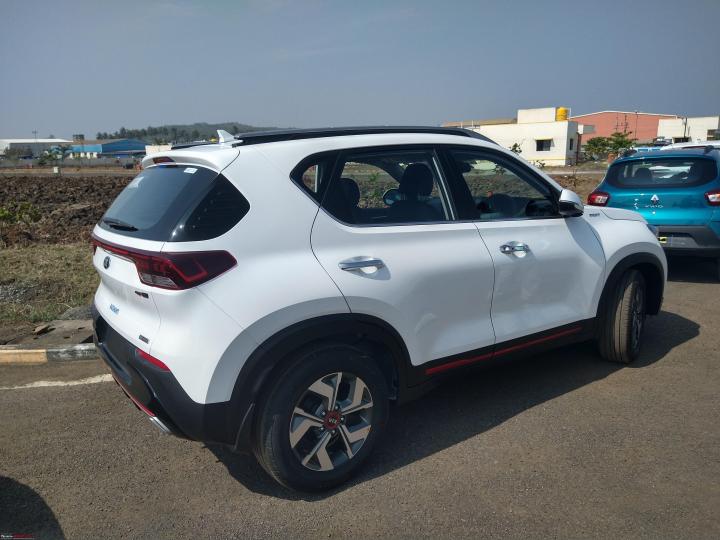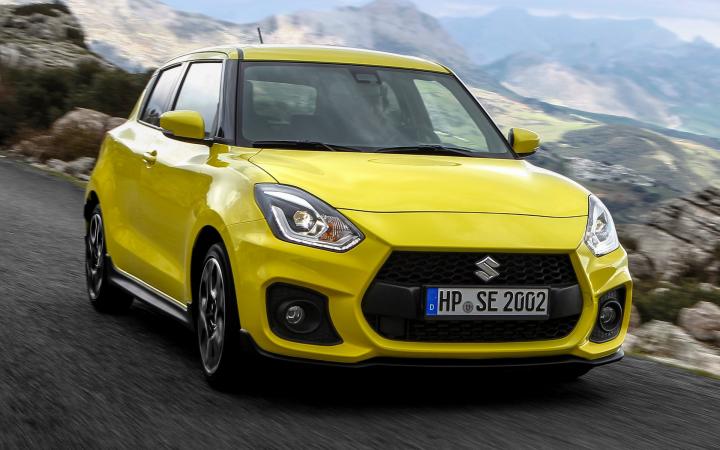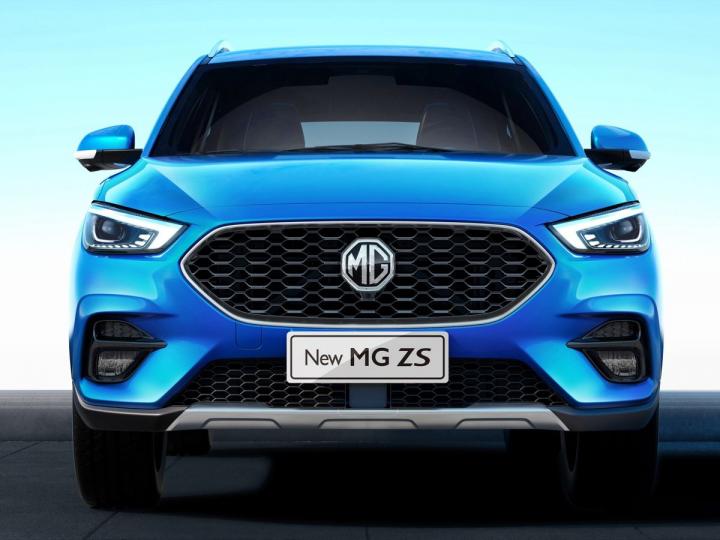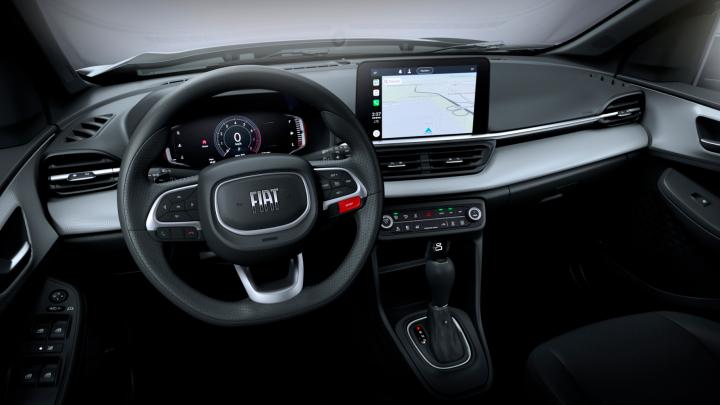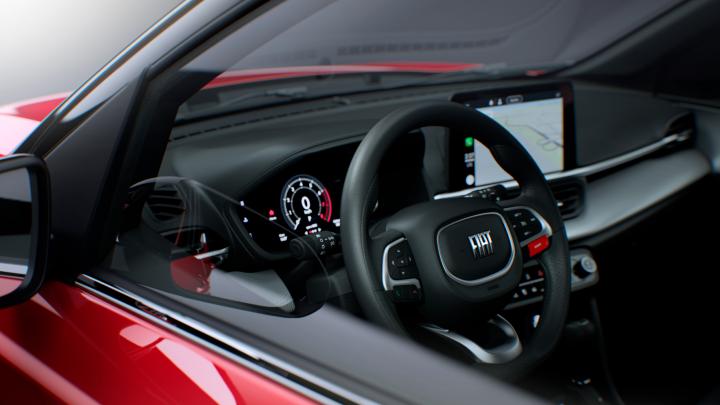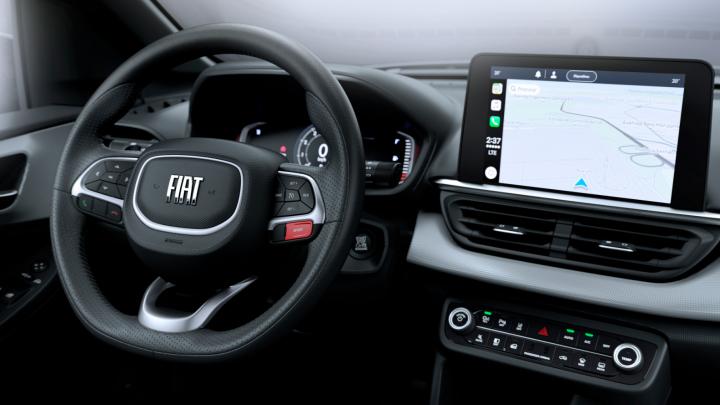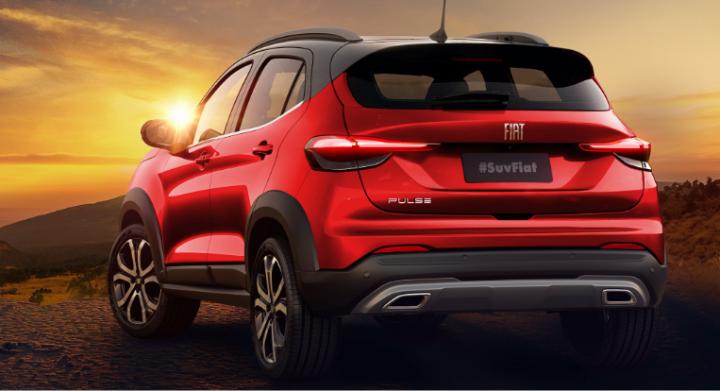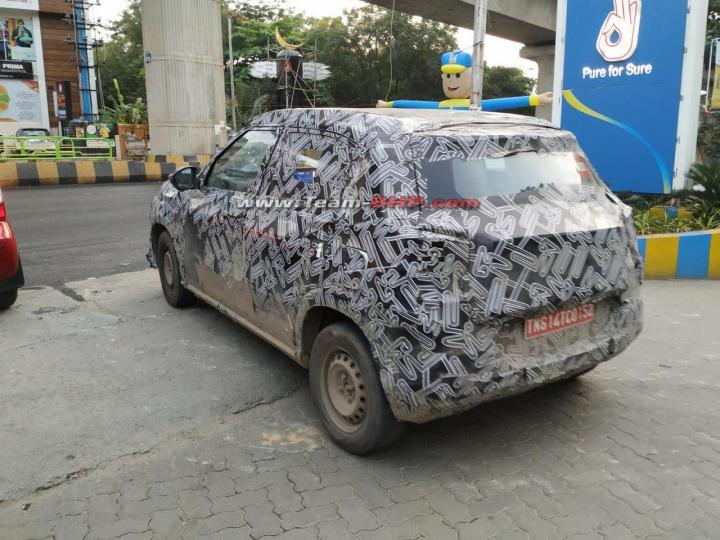News
Ownership review of my Kia Sonet GTX+
The real performance of the engine and DCT becomes evident only in Sport Mode. Performance in Normal and Eco modes is very relaxed.
BHPian xks64 recently shared this with other enthusiasts.
The following posts outline some thoughts and opinions of my new* Kia Sonet GTX+ 7DCT (1.0 Turbo), purchased in November 2020.
Summary of major likes and dislikes:
Likes:
- Powertrain: Smooth and lots of power for my driving style - even fully loaded. Rides very well on long drives.
- Ergonomics are good for me and my wife - physical buttons for important stuff.
- Good visiblity and driving position. Does not feel like you are struggling to manoeuvre in the city. That said, for pure city driving I would pick something smaller/narrower.
- Feature loaded variant. Coming to India from the US market many other cars/variants feel like penny-pinching.
- Powerful AC and Cooled seats are amazing for peak summer.
- Overall well put-together package.
Dislikes:
- Price/Variant options: Top variant is quite expensive, and lower variants miss out on stuff like airbags or cruise control etc.
- No option of split rear seat - even on top variant, and non-functional roof rails.
- There seems to be a lot of doubt about reliability of a tubo+DCT.
- (The remaining points are actually minor niggles - not deal-breaker points for me)
- UVO app/server is slow and clunky. Regular people will not have the patience to deal with it. :(
- Infotainment menus are a little hard to get around - takes a while to remember where some settings are.
- No truly keyless use possible like Nexon's fitness-band style key or Ford's famous door-mounted keypad.
Prelude:
(Or how we ended up booking the Sonet)
My wife and I are based in the Hubli-Dharwad area with family in Mumbai, Pune and Bangalore. Once the lock-down began, it became apparent that having a reliable and comfortable car was going to be necessary for highway duties, and the ageing Zen in our stable was just not going to cut it. Some additional requirements were:
- Must be ergonomic for me and the Mrs. (who is slightly shorter than average and finds many cars uncomfortable), Automatic highly preferred.
- Must have a reasonably good back seat for our elderly family (not too low, good ingress/egress).
- Good ground clearance and a little off-roadability: we are outdoorsy types and often go birding.
- Flexibility of a hatchback body style: Useful for carrying outsize loads, such as bikes, or having our dog ride in the back.
- Budget of around 15lacs on road: This was not a tight constraint and we were prepared to move a little.
As such we ended up squarely in the compact SUV area, and were initially looking at the usual suspects. For about two months I obsessed over TeamBHP posts, Youtube reviews and talked to friends and family trying to create a shortlist of models/variants, and creating spreadsheets to track all this info. I also compiled a "master list" of stuff to watch out for on a test drive (link later).
The Shortlist:
From the bottom, here's our initial shortlist, and reasons why contenders were rejected outright:
- XUV300: No automatic option; Ergonomic was bad for me and absolutely terrible for the Mrs. After a 10 minute test drive she vetoed it right out.
- S-Cross: Was on the shortlist because of good reviews on reliability/highway performance. However, the high price premium for the automatic put us off.In hindsight we should have test-driven it at least, and should have seriously considered buying a manual.
- Jazz: On paper this was a serious contender, but due to slightly lower ground clearance and lukewarm powertrain it was at the bottom of the list. Also, the higher variant seemed quite over-priced.
- Nissan Kicks (Magnite & Kiger were not launched at the time): Rejected outright due to some horror stories of service experience in our region.
- Polo: Was on the shortlist simply because the Hubli area service is simply exceptional, as attested by many close friend, despite horror story reviews of other owners in MH/KA.
- Ecosport: Very nearly made it to the final shortlist. After the test drive (a colleague's vehicle) we were quite impressed with the overall vehicle and dynamics but found the rear seat a little cramped for our liking.
The cars that made it to our final "serious consideration" short-list were:
- Nexon
- Venue
- Sonet
Quick note here: We started our process in Mid-October 2020, just as things were returning to "normal-ish" and demand had started picking up. Dealers were probably keen to talk to people with definite purchase plans, not to those on the fence. Nevertheless we had an excellent experience with the dealers at Tata (Manickbag Hubli), Kia (Nagashanti Hubli) Mahindra (Sutaria Hubli). Both Hyundai dealers in Hubli would barely talk to us until we were ready to pay the booking amount, and even then would dismissively tell us about 3 month waiting periods, and the online test drive request also went un-answered. Further, this also meant that it was a sellers market - so no discounts or deals were forthcoming.
The Final List:
We did fairly detailed test drives of the Venue (DCT version belonging to a friend - dealer never responded to our request for an iMT), Sonet (DCT and iMT) and Nexon (AMT only). Our findings were pretty much in line with what the Youtube reviews had said. In the end we dropped the Venue because the top DCT version had some funny misses (no rear arm rest, no rear washer/wiper) and felt a little cramped in the back and I didn't want to settle for the iMT. For a few days we went back and forth between the Nexon and Sonet:
- Nexon (Best safety record, great room in the back and solid build, wider service network).
- Kia (Beautiful refinement, far better powertrain feel of 1.0L Turbo + DCT, and really no compromise except split rear seat), and most importantly, was much more comfortable for my wife to drive.
And finally decided to spend the additional amount and go for the Sonet.
The purchasing process was a breeze - we took delivery 2 weeks after booking (could have been a little sooner if not for a delay due to some personal work), and absolutely no discounts. The main reason we paid the higher amount for the DCT was that we wanted an automatic and did not want to miss out on the 6 airbags, and moreover we were getting delivery in just a week as opposed to 3+ months for other models
Early Experiences:
In the first two weeks we or so have driven the vehicle about 200km on short local trips as we get used to the car. Here are some observations that other reviewers have missed ( in no particular order):
- The Sonet has 3 drive modes and 3 traction modes. Only one of these 6 can be selected at a time - i.e. if you press the drive mode button it cuts off the traction mode, and so on. The assumption here seems to be that the traction modes (Sand / Mud / Snow) are for off-road use and the Drive Modes are for on-road use.
- Connected Car Tech: I've always felt this is a bit of a fancy gimmick, but last week there was a situation where being able to unlock the car from my phone was a huge convenience (without it I would have had to walk 10 mins to just to get the key). One should remember, however, that for this to work, your phone *and* your car must have data connectivity. I wish more cars would come with a wearable key / band like the Nexon.
- Ventilated Seats: Are absolutely AWESOME! Even in the mild heat of of a sunny day it makes a big difference, I'm sure I will feel it even more during peak summer.
- The sound mood lamps are just a gimmick - as I had expected. Basically very mild RGB LED accent lights in the door and dash area.
- There is no dedicated SD/USB slot in the car. In the rare case that I do not connect my phone, there is no music other than AM/FM. WIll maybe keep a USB drive with MP3s in the car.
- [Rant] It's 2020 - why don't we all have wireless Android Auto / phone projection yet?
- Many reviewers have said that the Sonet rear seat space is a little less. There are no "big/tall" people in my family and we find it plenty roomy - even though it is slightly less wide compared to the Nexon.
- The Sonet, like many other cars today, has purely cosmetic roof rails. US/EU cars have loadable roof rails that can carry oversize items like canoes or skis (neither of which I foresee needing). Will see how much this impacts anything in the future.
- The real performance of the engine and DCT becomes evident only in Sport Mode. Performance in Normal and Eco modes is very relaxed.
- We had almost no choice of color, and we were not too particular on it, which is why we were able to get it very quickly.
- It appears that there is no play/pause button on the steering; only mute. Very annoying when listening to podcasts.
Photos:
The front 3/4 view: arguably the best look of the Sonet:
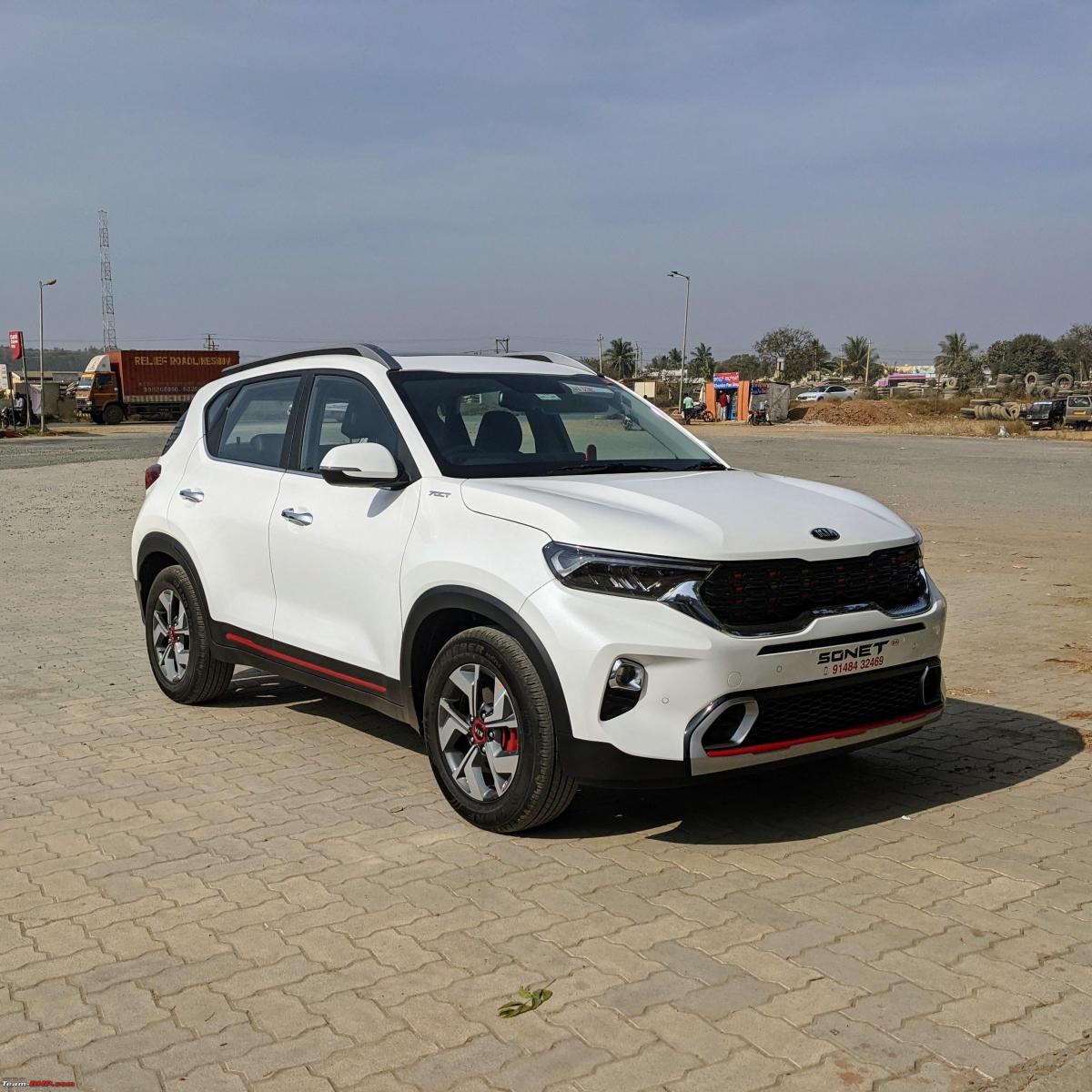
Here is the rear 3/4 view of the Sonet:

Full Frontal. I've liked the front fascia/grill for most Kia models, this one is no exception:
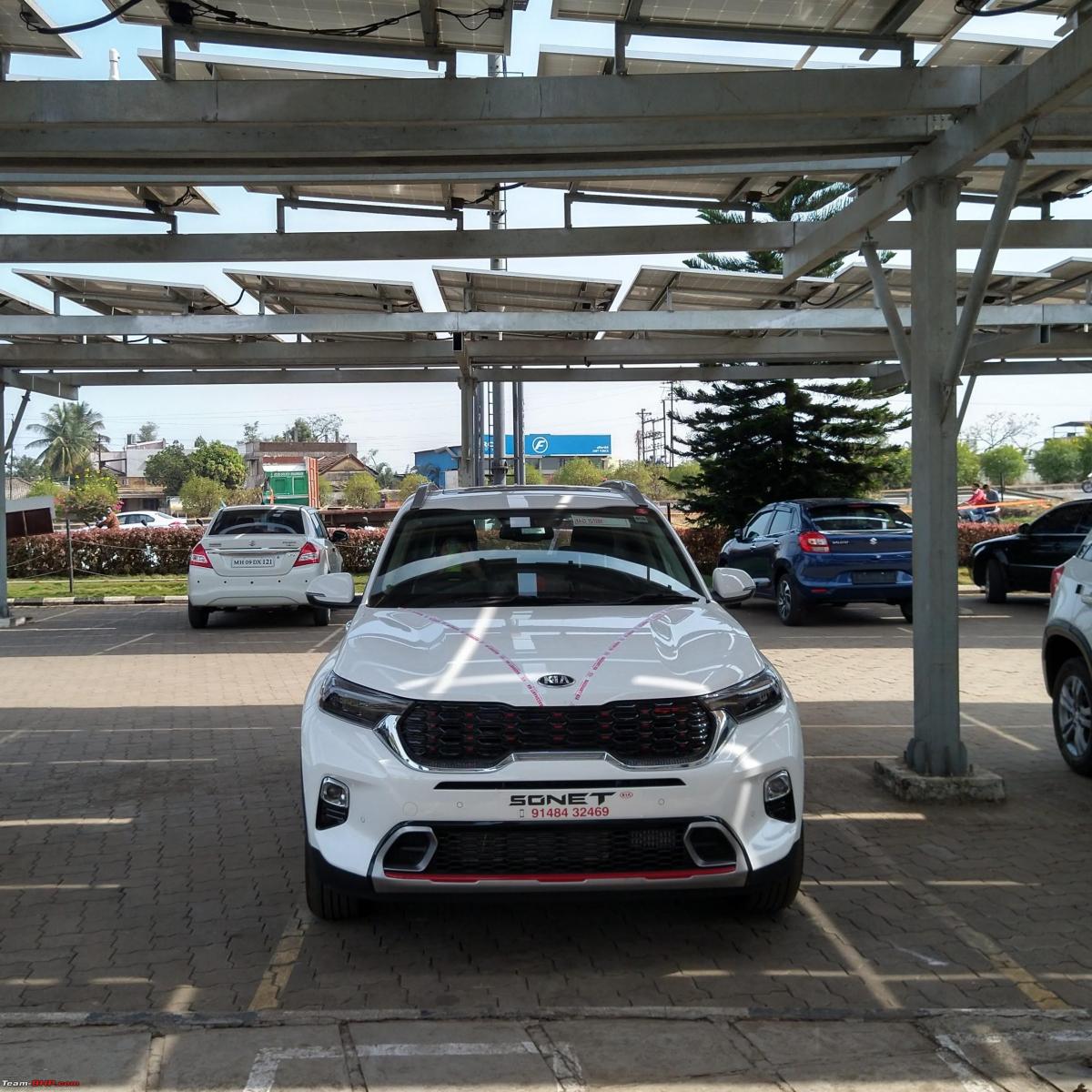
On a birdwatching trip in Hessaraghatta - making full use of the high ground clearance and "SUV" claims:

His royal highness riding in the back. With the rear seat folded down it makes a nice full flat bed and the window ledge is at a nice eye-level. - I am just missing having split-folding seats:
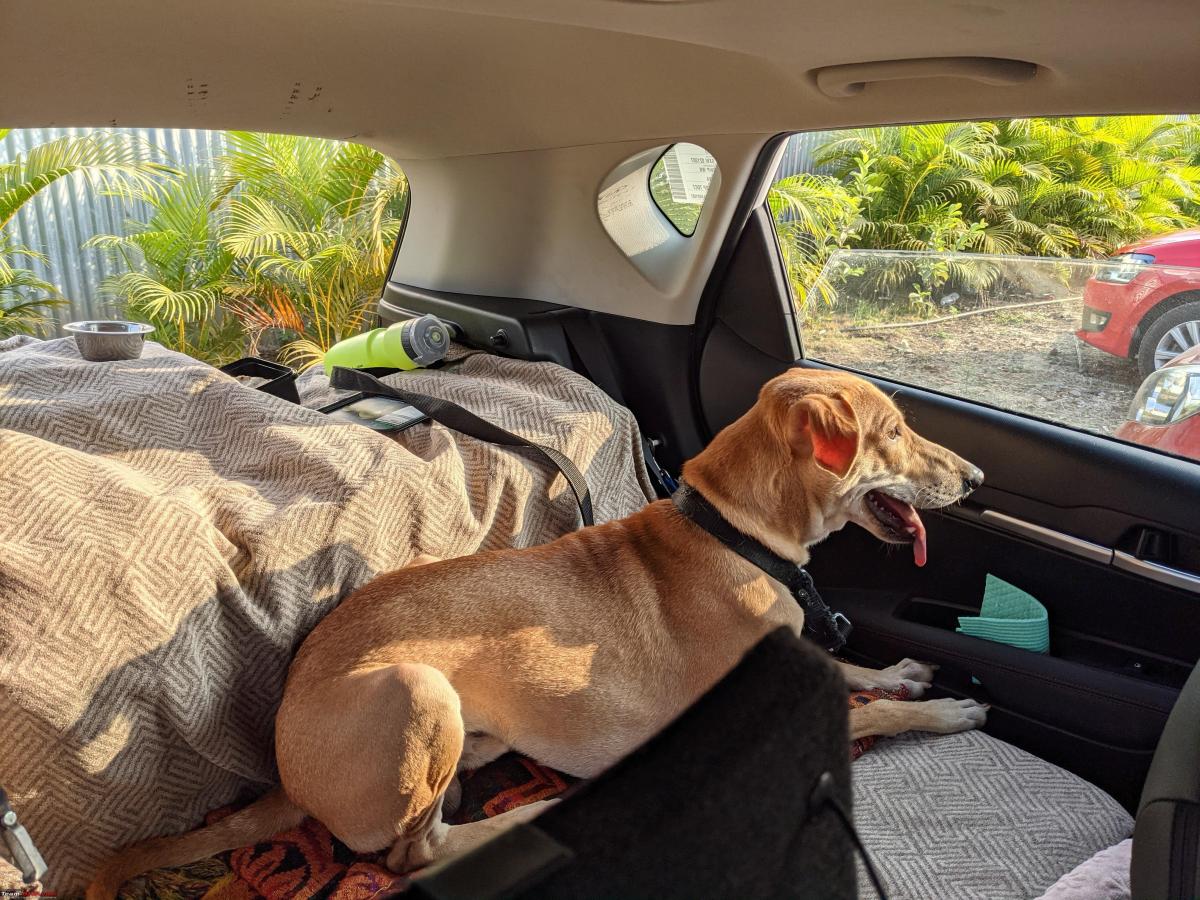
The whole reason I did not get a sedan was to have the ability to carry bikes and other gear. There are two bikes loaded up at the moment. With front wheel off and handlebar turned, the bikes fit vertically. The fact that the rear seat does not fold flat is certainly annoying, but manageable:

The LED lights look great, the auto lights / follow-home lights are particularly useful:
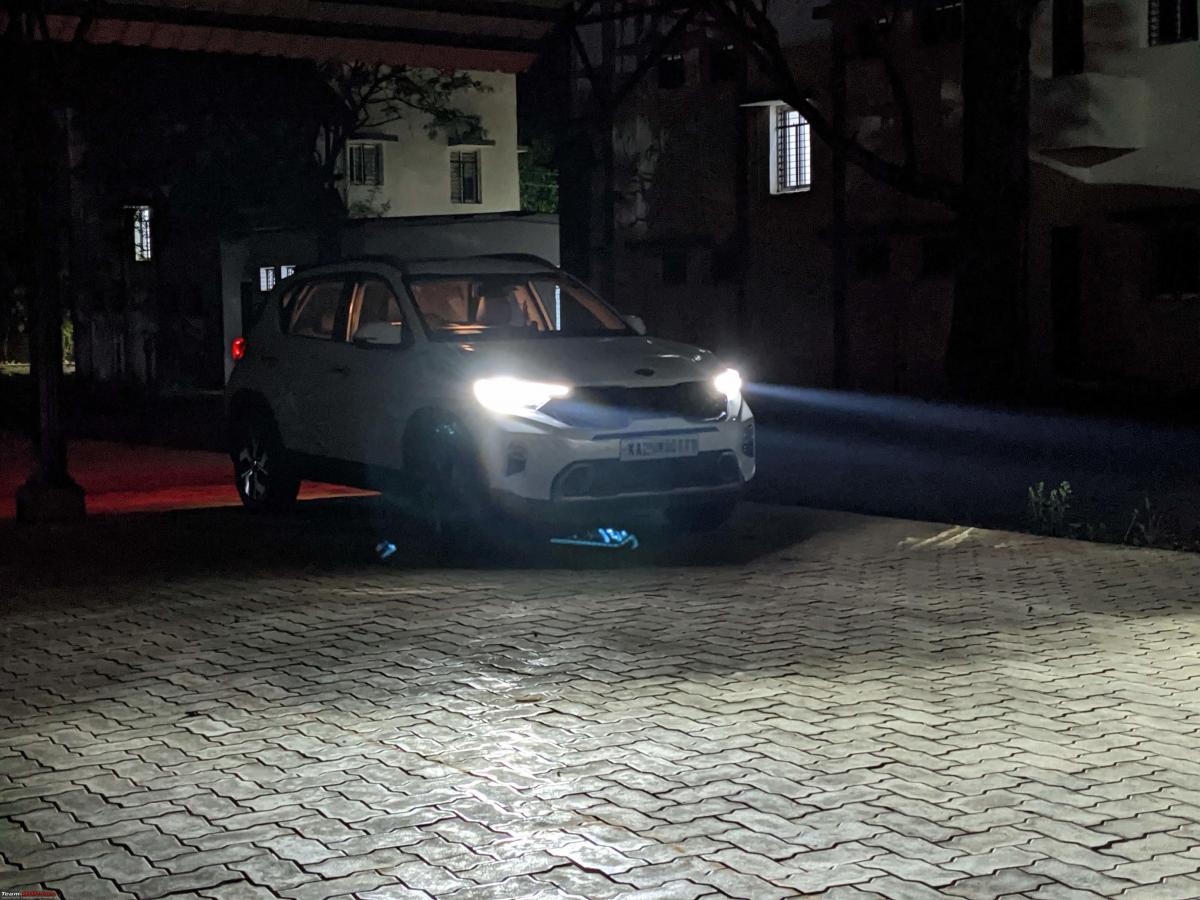
Due to lockdowns and work commitments the car did just over 1000km between Jan '21 to September '21. Living on campus there was no need to commute as well - hence the ridiculously low mileage:
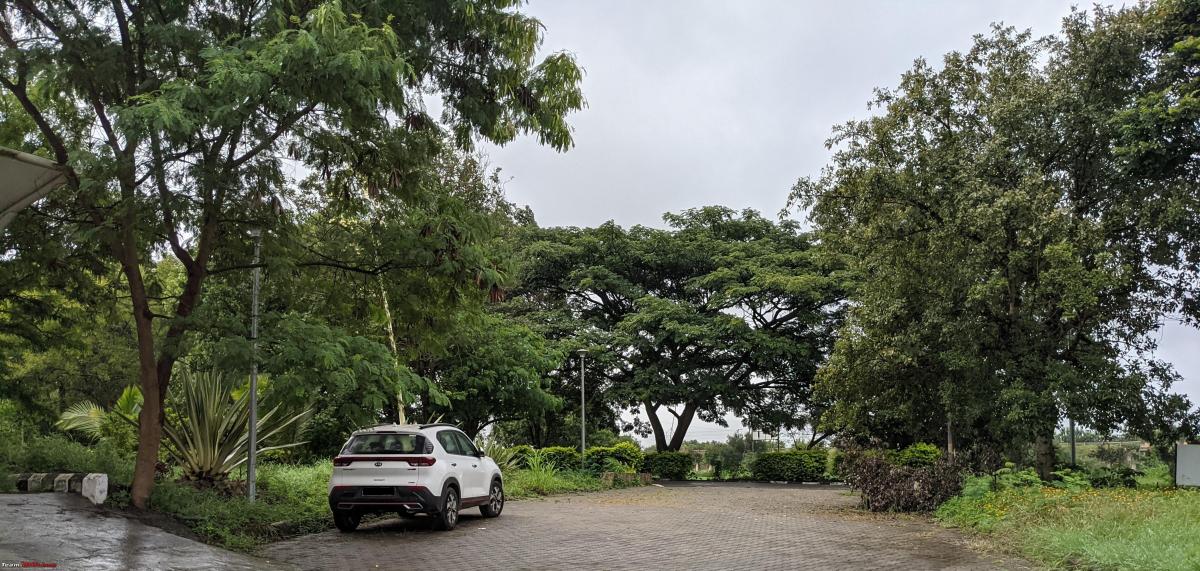
Finally when things had opened up in end of Sep / Oct we took a small trip into the Western Ghats with family (2 dogs included). Car performed flawlessly - and having the sunroof open while driving through the forests was a nice experience:

Continue reading xks64's review of his Kia Sonet GTX+ for BHPian comments, insights and more information.
- Tags:
- Indian
- Kia India
- Kia
- Kia Sonet
- Compact SUV
News
Rumour: Next-gen Suzuki Swift to spawn a crossover
The Swift Sport-based crossover could be powered by a 1.4L turbo-petrol mild-hybrid engine.
According to a media report, Suzuki plans to introduce a small crossover based on the next-generation Swift Sport. It could arrive by 2024.
The next-generation Suzuki Swift will be based on the updated Heartect platform. It is expected to debut sometime next year. The high-performance version called the Swift Sport is said to debut in 2023.
The Swift Sport could be powered by a 1.4-litre turbo-petrol engine paired with a 48V mild-hybrid system. The car will also feature a few chassis upgrades, including a stiffer suspension setup.
While details about the new crossover are scarce, the car could use the same 1.4-litre mild-hybrid engine as the Swift Sport, paired with Suzuki's AllGrip all-wheel-drive system.
Suzuki's new Swift-based crossover could be positioned between the Ignis and Vitara. It is still unclear if Maruti Suzuki would offer it in India.
Source: Bestcarweb
- Tags:
- Indian
- Swift
- Compact SUV
News
Tata Punch vs Maruti Vitara Brezza vs Hyundai Venue vs Others
The Tata Punch is lovely in every area, except for the one that matters the most = under the hood
BHPian Aditya recently shared this with other enthusiasts.
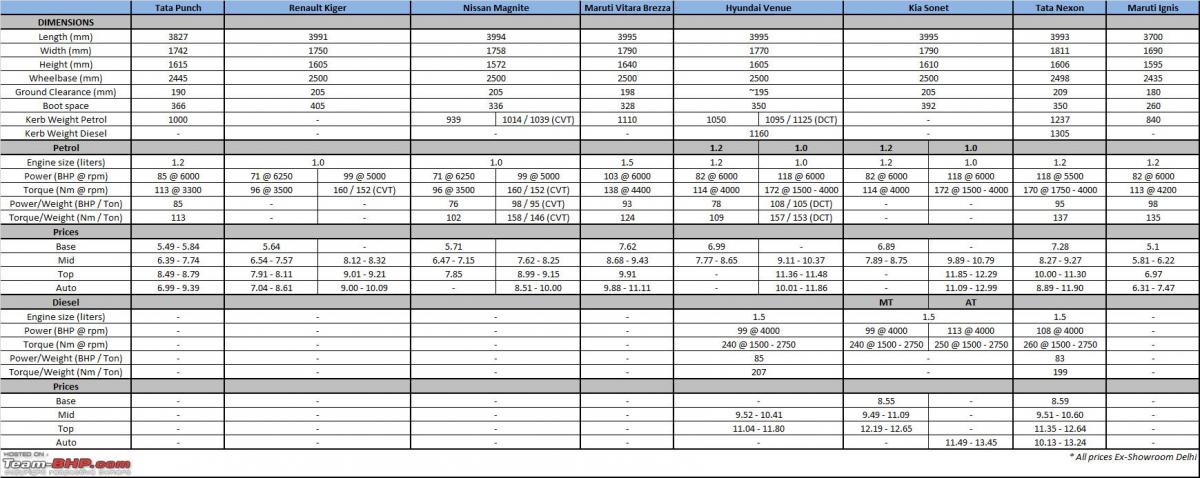
Tata Punch
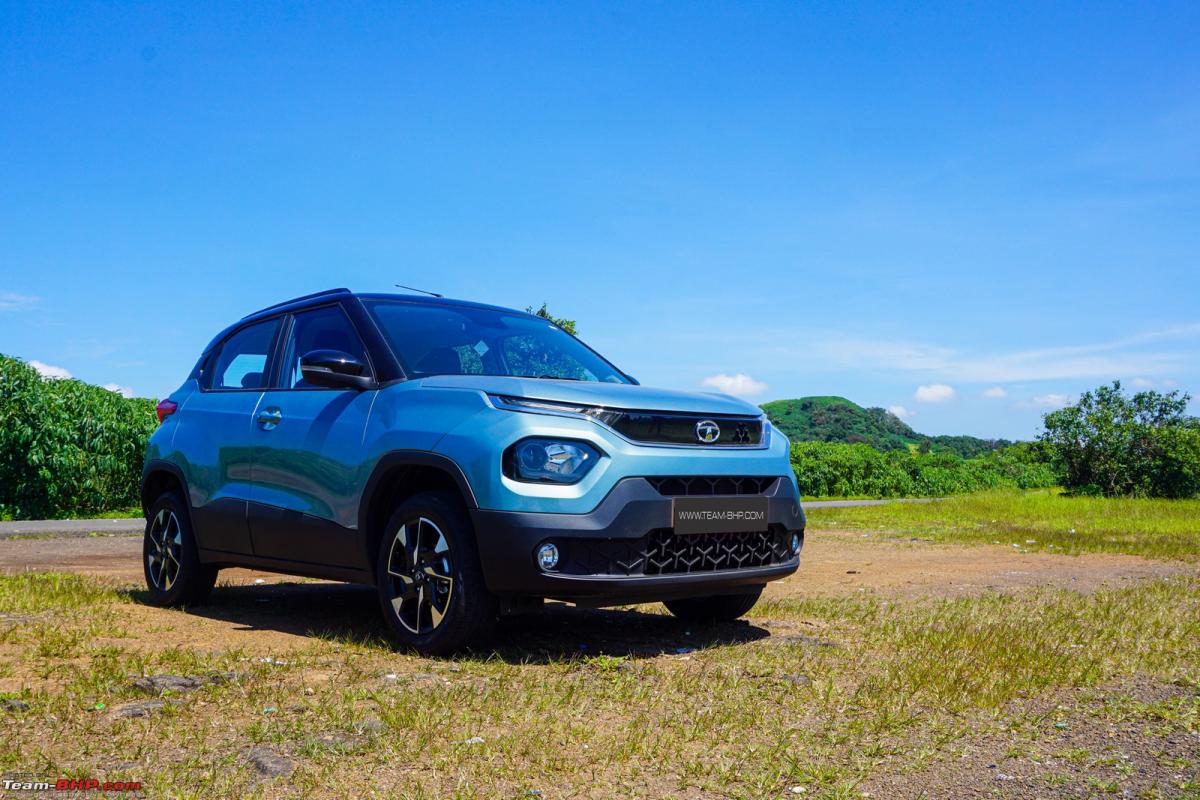
What you'll like:
- Snazzy styling! We love the mini-Harrier face and tight rear end
- Well-designed & practical cabin with enough space for 4 adults
- 366-litre boot is accommodating
- 1.2L NA petrol offers good driveability in the city. Performance is acceptable <90 km/h
- Sorted road manners & reassuring high-speed stability
- Enjoyable Harman 6-speaker ICE. One of the better systems in this segment\
- Features such as auto headlamps & wipers, cruise control, Traction Pro (AMT), cooled glovebox…with factory customization packs too
- A full 5-stars in the GNCAP! Safety package includes dual airbags, CSC, brake sway control, ISOFIX etc.
What you won't:
- 1.2L NA petrol’s highway performance is weak. At 100 km/h & up, more noise than action
- Suspension has a firm tune (R16 variants). It is compliant & liveable, but you do feel bad roads
- Jerky and slow AMT gearbox when competitors offer you smoother CVTs and torque converters
- 3-cylinder petrol cannot match the competition’s 4-cylinders in refinement & NVH
- No turbo petrol or diesel option. Period. Rivals & other Tata cars offer both
- Cabin width makes 4 adults welcome, not 5
- Some missing goodies such as an auto-dimming IRVM, split rear seat, rear AC vents, full-size spare…
- Tata's after-sales service quality is a hit or miss. Remains a gamble
Renault Kiger
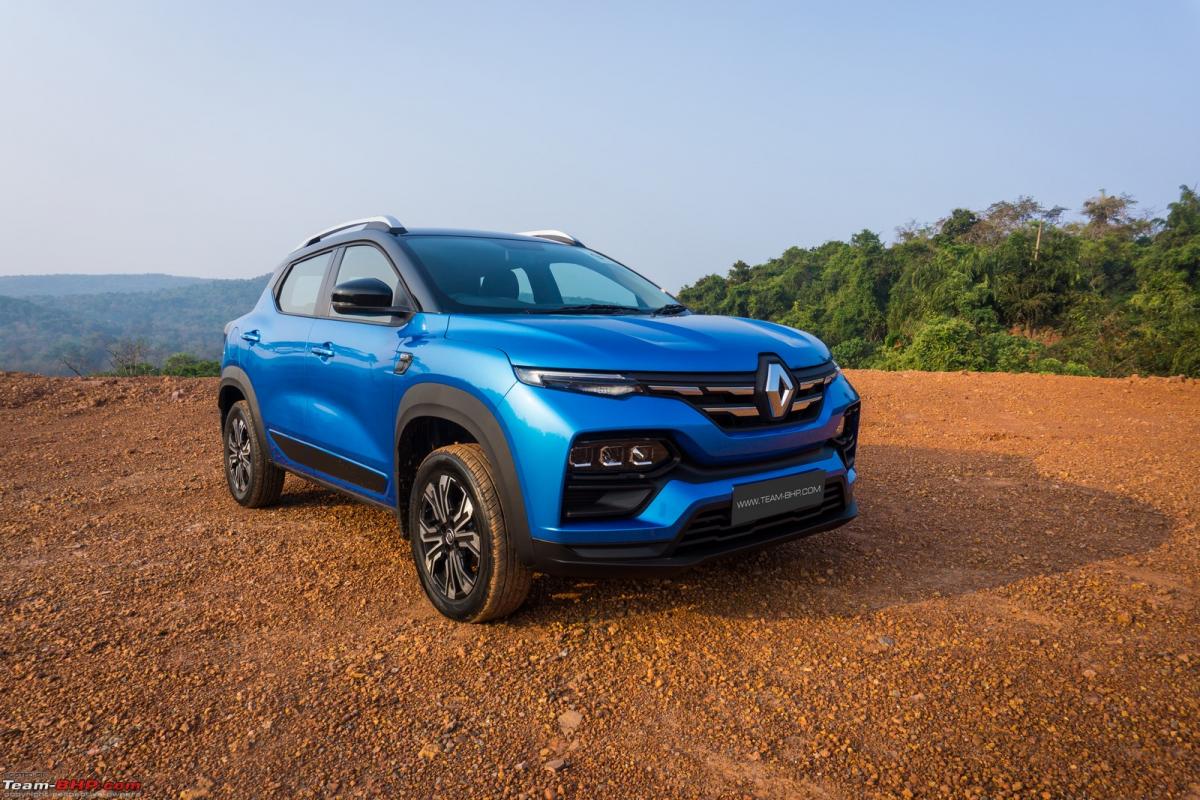
Nissan Magnite
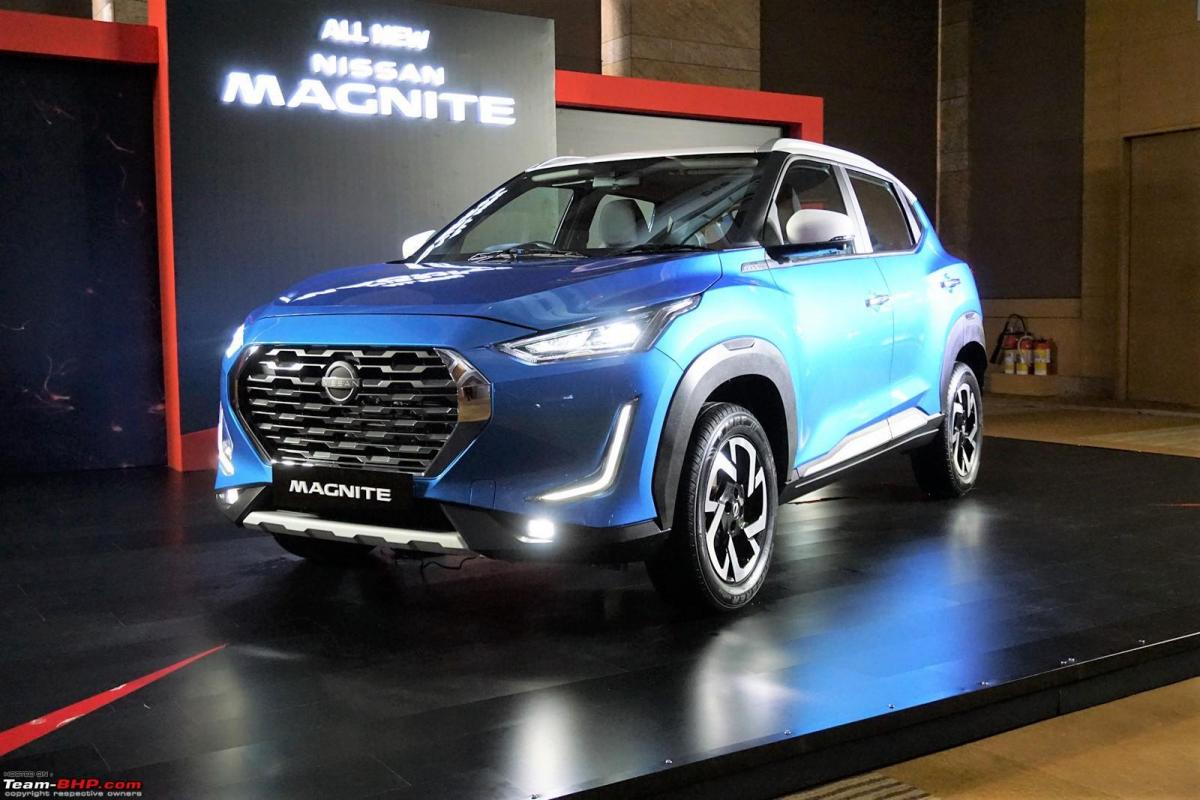
What you'll like:
- The Magnite looks really good…that handsome face is a head-turner
- Sheer value-for-money pricing. Turbo-petrol with a proper AT under 10 lakhs!
- Peppy performance from the Magnite’s 1.0L turbo-petrol engine
- Smooth well-tuned CVT in a sea of jerky AMTs. Has Sport and L modes too
- Healthy legroom for rear passengers. Space packaging is brilliant
- Impressive kit (cruise control, LED headlamps, rear air-con vents, 360-degree camera, wireless charger, wireless Android Auto & Apple CarPlay)
- 205 mm of ground clearance is more than enough for any kind of bad roads
- Safety kit includes ESP, TPMS, ABS, EBD & hill start assist
- Base variant also gets a reasonable kit, including a rear wiper. It’s not poverty-spec
What you won't:
- Stiff & basic ride quality. You feel each and everything on the road
- The Magnite is built to a cost and it does show, especially in the budget-grade cabin
- Lower variants’ 1.0L naturally-aspirated petrol is a boring, unimpressive engine
- Clunky, firm MT gearshift & a clutch pedal that has more weight than it should
- No diesel option available on the Nissan Magnite
- Cabin is narrower than some competitors. Narrow width makes it best for 4 adults
- Missing features such as an auto-dimming IRVM, full-size spare tyre…
- Doesn't have the finesse or quality of premium crossovers like the XUV300, Sonet etc.
- Nissan's tiny dealership network & lousy after-sales quality
Maruti Vitara Brezza
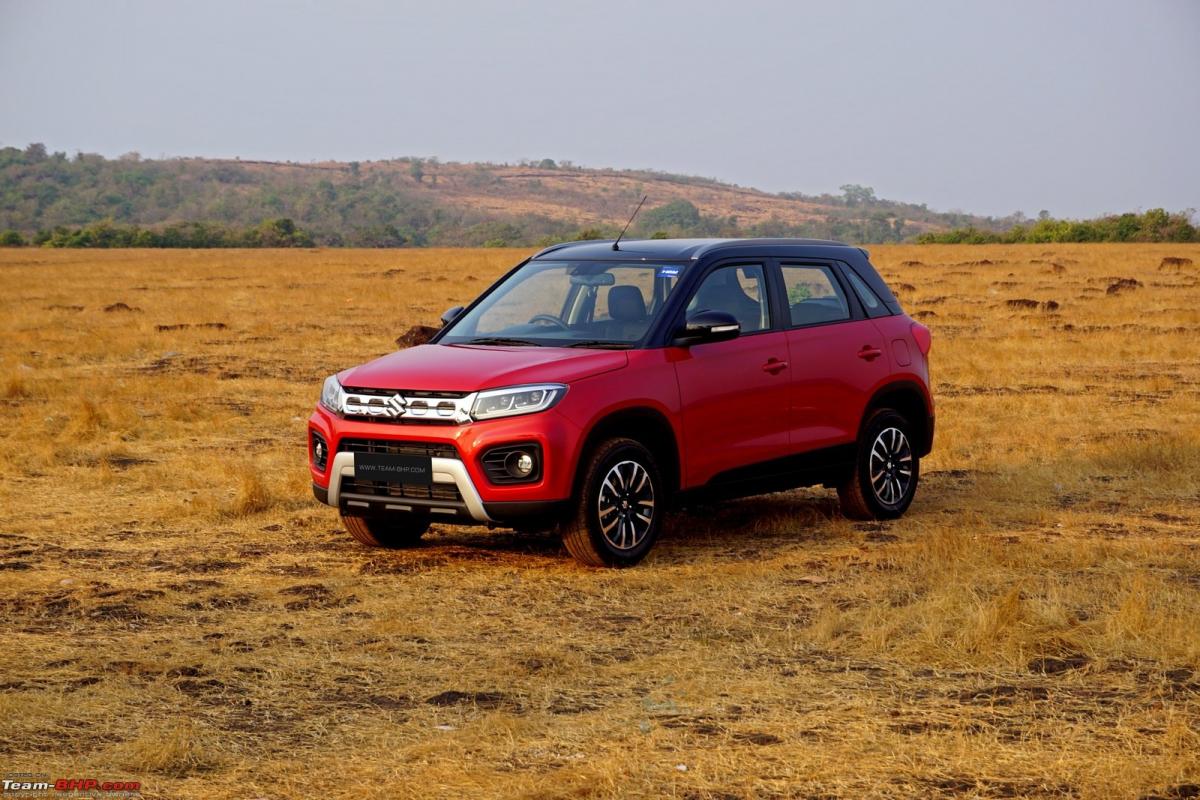
What you’ll like:
- A well-rounded Compact SUV with mature styling & mass-market appeal
- Competent 1.5L petrol offers excellent driveability & practicality
- Smooth torque-converter AT replaces the jerky old AMT. Gets SHVS tech
- Well-mannered suspension riding on big 215/60 R16 tyres. Good ground clearance as well
- Decent cabin space for a sub-4 meter car. Lots of storage & a powerful air-con too
- Features such as auto LED headlamps, auto wipers, cruise control, 7" touchscreen ICE etc.
- Dual airbags & ABS are standard. The pre-facelift version received a 4-star GNCAP safety rating
- Maruti’s excellent after-sales service, wide dealer network & fuss-free ownership experiences
What you won’t:
- No diesel option! Maruti’s BS6 1.5L diesel engine is still some time away
- This 1.5L petrol motor is uninvolving to drive. Enthusiasts, look elsewhere
- 4-speed Automatic gearbox feels old & outdated. No manual mode or paddle shifters either
- With the new 1.5L petrol, the car has lost its relative VFM positioning in the segment
- AT option commands a steep Rs. 1.2 lakh ex-showroom premium!
- Ordinary interior quality and design. The game has moved on with newer competitors
- Missing features by 2020 standards (6 airbags, sunroof, leather seats etc.)
- Boot has a practical layout but is still the 2nd smallest in the segment @ 328-litres
Hyundai Venue
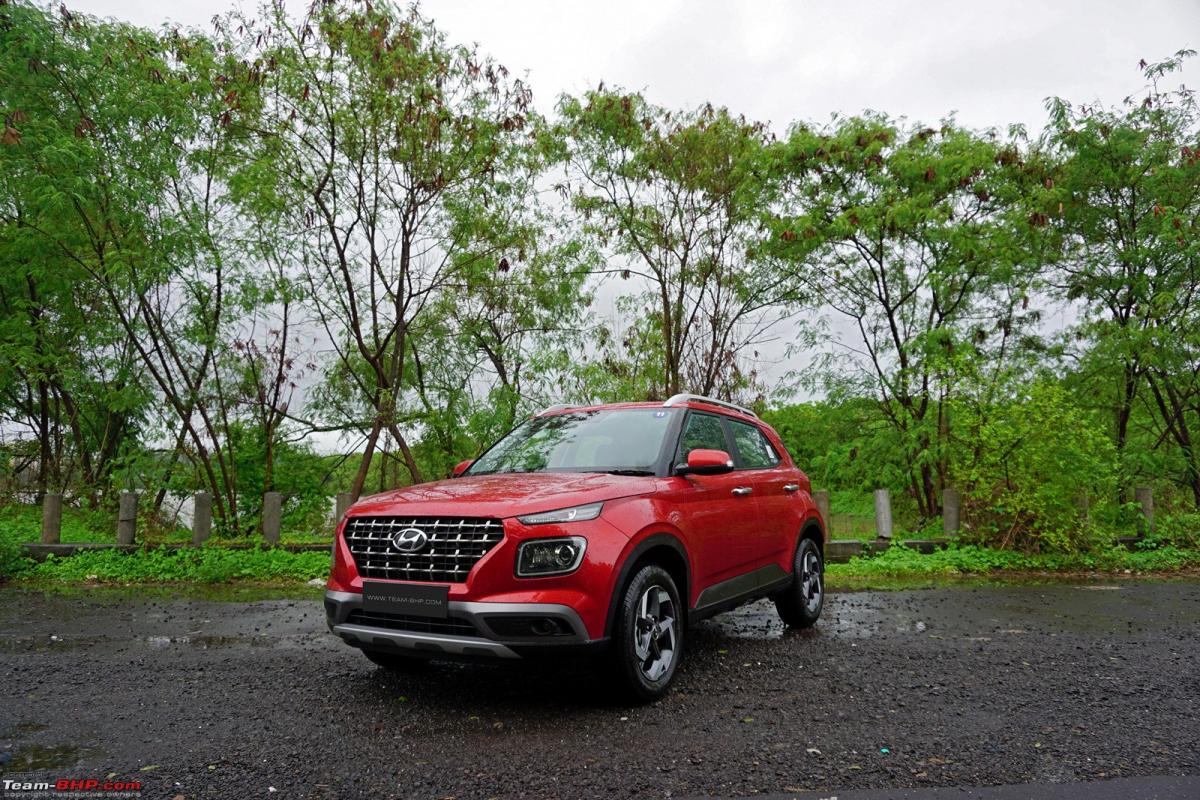
What you'll like:
- A mini-Creta in almost every way! Same formula, in a smaller package
- Precise build & quality (including interiors) are easily among the segment-best
- Competent engines mated to slick gearboxes
- Fast shifting dual-clutch Automatic gearbox available
- Balanced road manners. Very easy to drive too
- Loaded to the gills with equipment (sunroof, Blue Link telematics, cabin air purifier etc.)
- Top safety equipment includes 6 airbags, ESP, HSA and more
- Hyundai's competent after-sales & fuss-free ownership experiences
What you won't:
- Diminutive street presence. Looks more hatchback than SUV from some angles, especially the rear
- Strictly a 4-seater. All-black interior makes it cosy. Some competitors offer more spacious cabins
- Missing kit (auto wipers, auto-dimming IRVM, steering reach adjustment...)
- DCT doesn't have a sport mode or paddle shifters. Fingers crossed on its long-term reliability
- Weirdly, the highest SX(O) trim doesn't get the DCT or dual-tone colour options
- Some variant mishaps = e.g. crucial rear wash + wipe just on the topmost trim!
- AT only on the petrol, not the diesel. XUV300 & Nexon have Diesel ATs
Kia Sonet
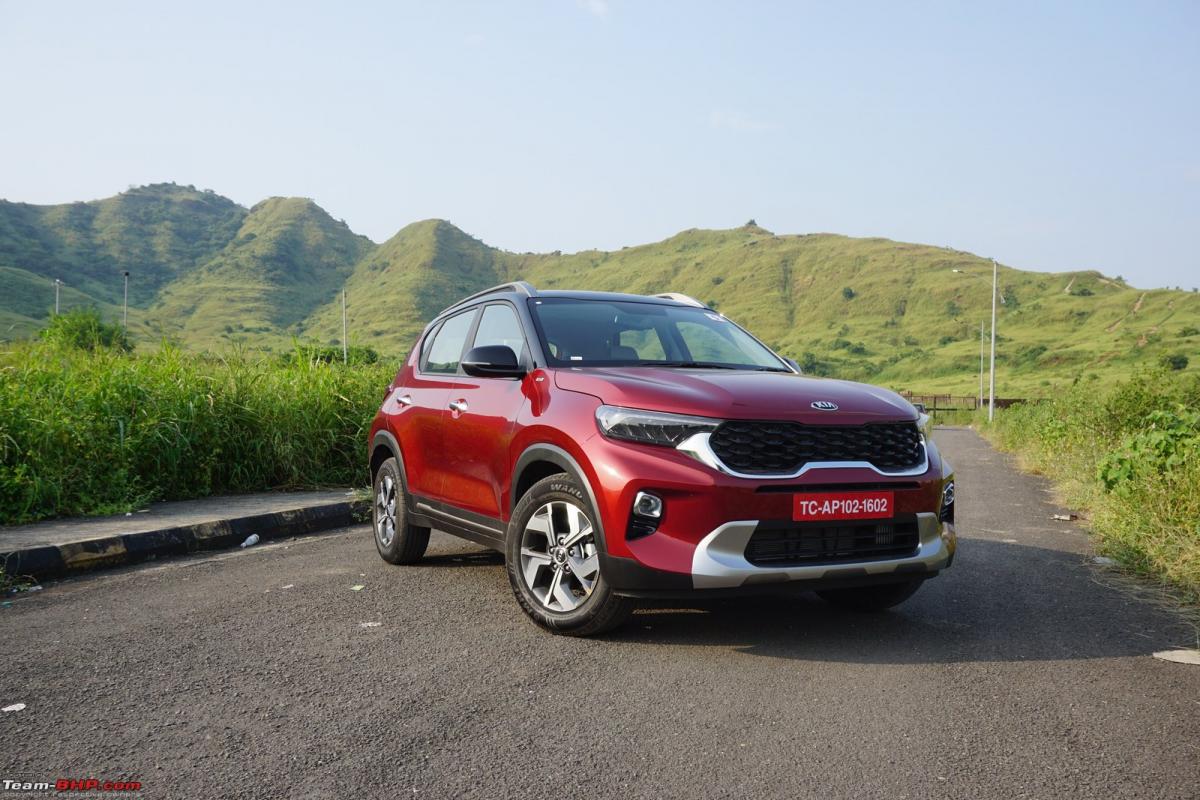
What you'll like:
- A mini-Seltos in almost every way! Same formula, in a smaller package
- Sharp & handsome styling. In our opinion, this is the best-looking Compact SUV
- Excellent spread of powertrains including a fast & enjoyable turbo-petrol
- Diesel AT is fantastic; the only smooth torque-converter gearbox in a sea of AMTs
- Well-tuned suspension offers a good balance between ride & handling. 205 mm GC too
- Top safety package includes 6 airbags, ESP, HSA, TPMS etc.
- Very enjoyable 7-speaker Bose sound system
- Impressive kit (ventilated seats, sunroof, auto LED headlamps, cruise control, wireless charger)
What you won't:
- Rear seat legroom is just adequate, while its limited width makes the Sonet a 4-seater
- Top variants are pricey! More expensive than its sibling, the Hyundai Venue too
- Some misses ( 60:40 rear seat split, auto wipers, steering reach adjustment, illuminated window buttons, full-size spare tyre on top trims…)
- Dual-clutch ATs (like the Petrol DCT) have a history of poor reliability in India
- As always with Kia, the variant spread is tough to figure out. Good luck finding your perfect Sonet!
- The tasty 1.0L turbo-petrol doesn’t come with a manual gearbox. Venue has that option
- Waiting periods are a couple of months-long for some trims
Tata Nexon
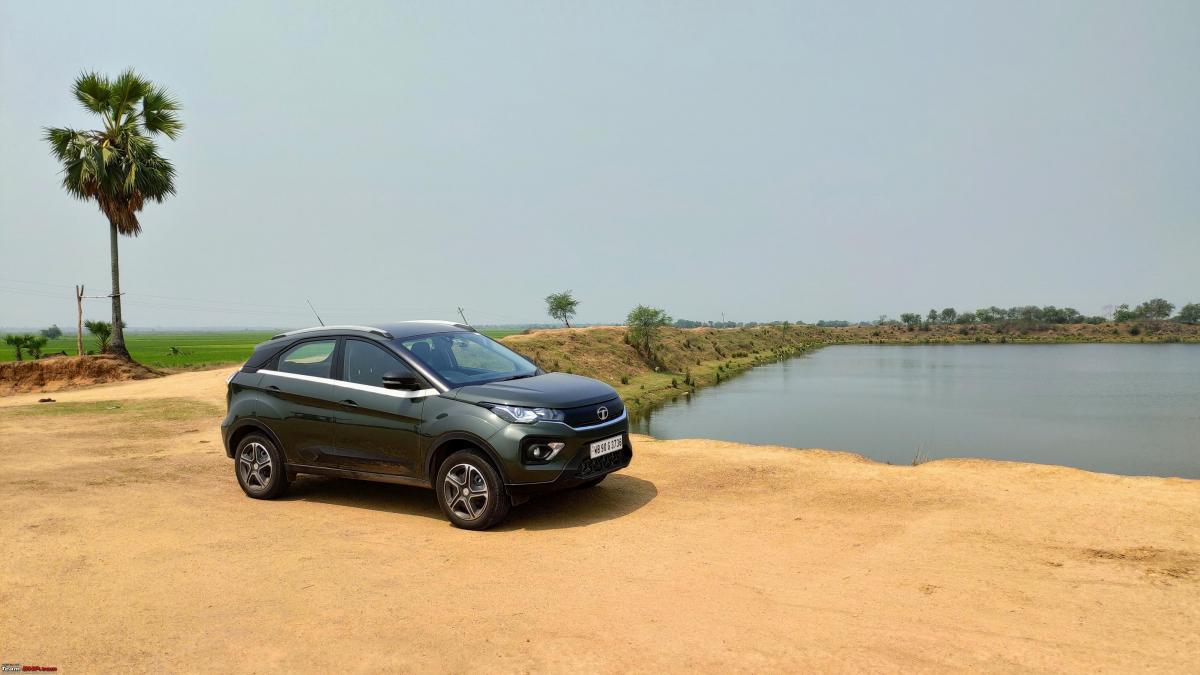
What you’ll like:
- Very well-priced for what it offers. Undercuts all rivals
- Funky styling ensures that the Nexon stands out from the crowd
- 5-star NCAP safety rating & a solid build, unlike many of its flimsy competitors
- Nice, spacious cabin with comfortable seats. You get a practical 350-litre boot too
- 1.5L diesel & 1.2L petrol offer good performance. Diesel is especially impressive
- Balanced road manners for such a tall car. Fine EPS & 209 mm of ground clearance!
- Loaded with features: Driving modes, LED DRLs, reversing camera, 8-speaker ICE etc.
- Dual airbags, ABS & Isofix child seat mounts are standard on all variants
What you won’t:
- Overdone design will be a turnoff for many of you. Rear-end is way too busy
- Jiggly low-speed ride; bumps are felt in the city (unlike other Tata cars)
- 3-cylinder petrol can't match 4-cylinder competition in NVH. Has lag too
- The observant eye will notice some rough edges in fit, finish & quality
- Concerns over long-term reliability, more so of the freshly developed engines
- Missing essentials (telescopic steering adjustment, auto-dimming IRVM, proper dead pedal)
- Tata's inconsistent after-sales experience is far from that of Maruti & Hyundai
- Shorter service/checkup interval of 6 months & 7,500 km (rivals have 12-month gaps)
Maruti Ignis
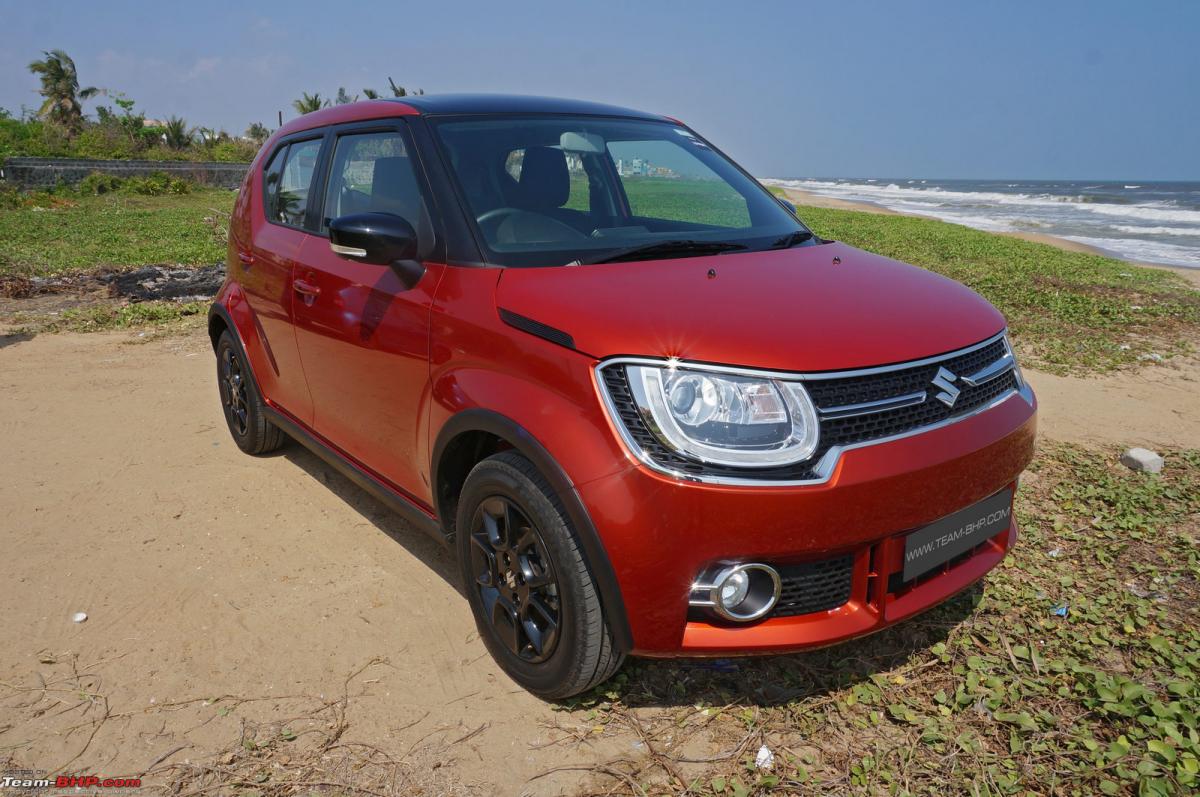
What you'll like:
- Unique, funky design - exterior & interior stand out in a crowd. Customisation options available
- Smart packaging! Good legroom & headroom in such a small car. Useable 260-litre boot too
- Peppy petrol engine and AMT
- Dual airbags, ABS with EBD and ISOFIX child seat anchors are standard across all variants
- Maruti's widespread service network, excellent after-sales support & fuss-free ownership experiences
- Features such as LED projector headlamps + DRLs, reversing camera, Apple & Android ICE, navigation, electrically-foldable ORVMs etc.
What you won't:
- Simply overpriced, not a VFM Maruti. Top trim is especially pricey
- You can buy more accomplished cars for a little more (Baleno) money
- Weird rear-end styling. Overall, the unconventional looks will polarize opinions
- No turbo petrol or diesel option. Period. Rivals offer both
- AMT, although improved, still can’t match conventional ATs on smoothness or speed
- Narrow cabin width. Rear seat is better for 2 adults than 3
- 32-liter fuel tank is too small for this segment. Even the humble Alto gets a larger tank
Here's what GTO had to say on the matter:
The Sonet is my top choice among all the Compact SUVs. It's got looks, style, equipment, good engines & a sorted suspension. Second choice, Nexon.
The Punch is lovely in every area, except for the one that matters the most = under the hood!!! That 1.2L NA motor is weak, the AMT is horrendous & the pricing of higher variants too much. When Tata gives it a turbo-petrol, I will consider it. Problem is, they haven't left pricing room for the turbo-petrol.
Here's what BHPian Shreyans_Jain had to say on the matter:
There is no car in this segment that is complete in all respects. They all have a catch, a compromise attached, a deal-breaker if you will. Nexon is excellent on most counts but is let down by the stupid AMT and the now optimistic pricing. Ditto for the XUV300, which has the additional handicap of a tiny boot. Sonet and Venue are cramped for space and have questionable safety. Brezza is old, feels outdated and makes do with the obsolete 4 speed AT. There is no redeeming CNG option either. I don’t think Ignis and Punch belong to this category of vehicles, they are a full segment down in all respects.
Surprisingly, it is the Kiger and Magnite that seem to provide the best overall combination of powertrains, space, features, safety and value. Granted, the cabin isn’t as well-appointed as the Venue. But the overall proposition is very good and the price tag is killer. Especially for the turbo petrol CVT.
Too bad the Ecosport has been discontinued, it would have still been my top pick otherwise.
Here's what BHPian harry10 had to say on the matter:
Voted for Sonet.
I own the D-AT one. Engine and gearbox are a gem. All required features are present and then some. Space is good enough for a 6.1 driver like me. Ergonomics are sorted, interiors are pleasing and feel roomy, handling is almost like a sedan with negligible body roll, A.S.S has been a good experience so far, looks are subjective but I like it. Mileage is between 14-16kmpl in NCR with AC and highways it can easily give 20kmpl. Also, NVH is brilliant, coming from a diesel Honda City this is super silent.
Stiff suspension is the only negative for our potholed roads, however with the right tyre pressure and once you learn to adjust your driving style it's easily negotiable. No GNCAP rating so I will give it a benefit of the doubt until it's done but I find the build quality better than my previous Honda City. Also, the thud from the doors and heavy bonnet is a little reassuring.
All in all, at 4300km ODO currently I am a very satisfied owner so far. Touchwood
My only other contender was Nexon and it would have won but for one deal-breaker - AMT gearbox. Would have surely bought it if there was a TC unit. Tata needs to sort this out as I know a lot of people who didn't buy Nexon just because of the gearbox.
Here's what BHPian amvj had to say on the matter:
I voted for the Nexon.
Pros:
- 5 star NCAP rating.
- Huge ground clearance.
- Good Diesel engine.
- Good Handling and steering.
- The interiors look decent.
- Very little niggles compared to other Tata products.
- The front three quarters look decent compared to over-styled Sonet or ugly Venue or the dull and boring Vitara Brezza.
Cons:
- Digital speedo is an eyesore. Looks like a cheap Casio watch.
- The rear design and a white stripe along the body is ugly.
Check out BHPian comments for more insights and information.
- Tags:
- Indian
- Compact SUV
- Comparo
News
MG to launch Brezza, Venue, Nexon rivaling sub-4m SUV
The new platform will serve as the base for not only a sub-4 meter SUV but also a hatchback and an MPV.
MG Motor India is gearing up to launch the Astor - a new crossover that will be positioned below the Hector. However, that's not the only small SUV that MG has in the pipeline for India.
According to a recent report, the carmaker is developing a new platform that will spawn a sub-4 meter SUV. It will compete with the likes of the Maruti Suzuki Vitara Brezza, Hyundai Venue and Tata Nexon.
The report states that MG had initially thought of re-engineering the Baojun 510 into a sub-4 meter model. But instead, the carmaker has now decided to develop a completely new platform that would serve as the base for not only a sub-4 meter SUV but also a hatchback and an MPV.
Right now, the carmaker's main focus is on expanding the production capacity at their Halol plant to 1,00,000 units per annum. This is being done to accommodate the Astor. It is said that MG will enter the sub-4 segment only after its second plant comes online.
MG's sub-4 meter crossover is expected to debut post-2023, followed by the MPV and hatchback.
Source: Autocar India
News
Fiat Pulse compact SUV interiors unveiled
The Fiat Pulse is said to be underpinned by FCA's new MLA platform.
Fiat unveiled its all-new Pulse compact-SUV earlier this year. Now, the company has released the first set of images revealing the interiors of the SUV.
The new Fiat Pulse features a clean and minimalistic cabin layout while being equipped with a host of features and equipment. The cabin of the compact SUV comes with a 7.0-inch fully digital instrument cluster, a 10.1-inch floating touchscreen infotainment system with smartphone connectivity, a 'Sport' button on the steering wheel, automatic climate control, and plenty more.
The Fiat Pulse is said to be underpinned by FCA's new MLA platform, capable of incorporating newer technologies such as 4x4 and hybrid systems in the future. The Pulse is said to be around 4 metres in length, positioning it below the Jeep Renegade in FCA's global lineup.
The compact SUV from Fiat will come powered by two engine options. These include a 1.3-litre, 4-cylinder, petrol engine producing 109 BHP and 140 Nm, paired with a 5-speed manual, as well as a 1.0-litre 3-cylinder turbo-petrol unit, churning out 120 BHP and 196 Nm, mated to a CVT transmission.
- Tags:
- Indian
- Compact SUV
- International
News
Skoda’s India-specific sub-4 m SUV could arrive by 2023
The vehicle is being referred to as project 2.5. Skoda plans to keep its price competitive by localising over 95% of its parts.
Skoda Auto Volkswagen is planning to introduce a new sub-4-metre SUV in India. This segment contains some of the highest-selling cars in the country such as the Maruti Vitara Brezza, Hyundai Venue, Kia Sonet and Tata Nexon. The segment accounts for 15% of the overall passenger vehicle market. With 50,000 units sold a month, more than half of the utility vehicles sold in India are from this segment.
The new SUV is expected to be designed in Europe. But, Skoda plans to keep its price competitive by localising over 95% of its parts.
According to a media report, the Skoda-badged model will be India-specific and will go on sale in the second half of 2023. The vehicle is being referred to as project 2.5. At present, the company has a market share of less than 1.5%. With the new model, by 2025, Skoda is looking to increase this share to 5%. It plans to sell 50,000 units of the SUV per year.
Under its 2.0 strategy, the Volkswagen Group plans to invest more than 1 billion euros in India. The group plans to introduce a sub-compact SUV since sub-4 metre vehicles benefit from a significantly lower tax rate, compared to those greater than 4-metres in length.
Source: ET Auto
- Tags:
- Indian
- Volkswagen
- Compact SUV
News
Brazil: New Fiat compact-SUV to be called Pulse
Fiat has confirmed the name 'Pulse' for its new compact-SUV after it won the public poll.
Fiat has announced that its new compact-SUV will be called 'Pulse'. The new Fiat Pulse was unveiled earlier this year, codenamed 'Progetto 363' and is expected to go on sale in the Brazilian market later this year.
The Italian carmaker held an online public poll, allowing prospective customers to choose the name for the new SUV. Of the three names shortlisted, the 'Pulse' name won the poll with 65% of the votes. The other two names were Domo and Tuo, both of which managed just 25% and 10% of the votes, respectively.
The new Fiat Pulse is expected to be underpinned by the brand's new modular platform, called MLA. The new platform is said to be stiffer and stronger than the previous PM1 architecture. The new platform is also said to be capable of incorporating newer technologies such as hybrid and 4x4 powertrains in the future.
The company also announced that the Pulse will have a length of around 4 metres, positioning it below the Jeep Renegade SUV, in FCA's global line-up.
The Fiat Pulse will come powered by two engine options. These include a 1.3-litre four-cylinder engine producing 109 BHP and 140 Nm, paired with a 5-speed manual gearbox. The second engine is a 1.0-litre three-cylinder turbo-petrol unit churning out 120 BHP and 196 Nm, mated to a CVT transmission.
- Tags:
- Indian
- Compact SUV
- International
News
Fiat Progetto 363 SUV for Brazil breaks cover
Fiat's new crossover could be called Tuo, Dumo or Pulse.
Fiat has taken the wraps off a new crossover, codenamed Progetto 363. It will go on sale in South American markets later this year.
Fiat Brazil has shortlisted three names for the model. These include Tuo, Dumo and Pulse. The company is conducting an online poll that will decide the official name of the car.
The styling of the Progetto 363 is inspired by the Strada four-door pick-up. It features an upright front fascia with a large FIAT logo in the centre. The grille is flanked by sleek wraparound LED headlamps. The rear of the car reminds us of the Audi Q3. It has a similarly shaped rear hatch. The SUV gets black cladding around the wheel arches and dual exhausts.
The Progetto 363 shares its platform with the Fiat Argo. It will be offered with a 126 BHP 1.0-litre, direct-injection turbo-petrol engine, alongside a 1.3-litre turbo-petrol unit and a 1.3-litre naturally aspirated motor.
- Tags:
- Indian
- Compact SUV
News
Project 516: Jeep's smallest SUV yet coming up
The Jeep crossover will be based on the CMP platform and will be positioned below the Renegade.
Jeep is reportedly working on a new crossover codenamed Project 516. It will be positioned below the Renegade in Jeep's product line-up.
Now, according to a media report, the new model is likely to enter production in 2022. It will be based on the CMP platform that is shared with other Stellantis brands like Citroen, Peugeot, Vauxhall and DS.
Powertrains for the Project 516 crossover could be sourced from PSA. It is expected to be offered with petrol engine options at launch, with a mild-hybrid variant likely to be introduced by early 2024. The latter will have a front-wheel drive layout with an electric motor positioned between the engine and gearbox. An electric variant is also said to be in the pipeline. It could debut by 2023.
Fiat is also said to be working on a similar crossover based on the same platform. Codenamed Project 364, the crossover is expected to go into production in October 2023.
Source: Autonews
- Tags:
- Indian
- Compact SUV
- Jeep Renegade
News
Citroen CC21 crossover to be unveiled on May 20
The CC21 is expected to be launched in India around September this year.
Citroen kicked off its India operations with the launch of the C5 Aircross earlier this month. The French carmaker's second offering will be a crossover codenamed CC21. According to a media report, the new model will be unveiled on May 20, 2021.
The CC21 is part of Citroen's "C Cubed" program. The crossover will be manufactured at Citroen's manufacturing facility located at Thiruvallur, Tamil Nadu. It is expected to be launched in India around September this year. The car will also be introduced in emerging markets in North Africa and South America.
The CC21 will be based on Citroen's modular CMP platform. The SUV will feature a quirky exterior with headlamps positioned on the front bumper and slim LED daytime running lights on top.
Reports suggest that the car could be offered with a 1.2-litre, turbo-petrol engine. Transmission options might include a 5-speed manual and an automatic gearbox.
Source: Challenges
- Tags:
- Indian
- Compact SUV
- C3 Sporty
Pages




